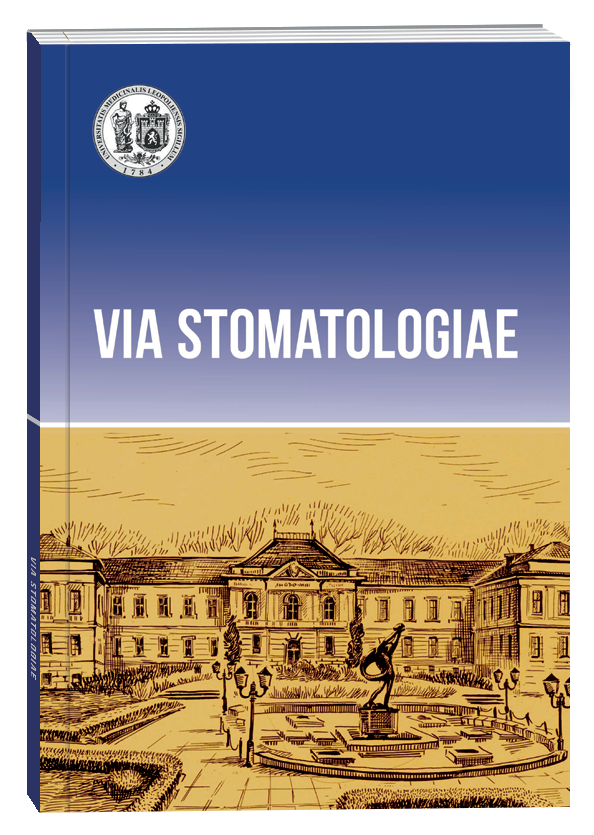ЕЛЕКТРОМІОГРАФІЧНА ОЦІНКА ЖУВАЛЬНИХ М’ЯЗІВ У ПАЦІЄНТІВ З ДИСТАЛЬНИМ ПРИКУСОМ
DOI:
https://doi.org/10.32782/3041-1394.2024-1.6Ключові слова:
електроміографічна активність, дистальний прикус, жувальні м’язи, скроневі м’язиАнотація
Електроміографія є найбільш об’єктивним і надійним методом оцінки функції та працездатності м’язів шляхом визначення їх електричних потенціалів, оцінки ступеня та тривалості м’язової активності. Основною метою поверхневої електроміографії є виявлення сигналів від багатьох м’язових волокон у ділянці детектуючих поверхневих електродів. Дослідження багатьох зарубіжних і вітчизняних науковців визначили вплив сагітальних аномалій прикусу на функцію жувальних м’язів. Метою нашого дослідження було встановлення взаємозв’язку між дистальним прикусом та активністю жувальних м’язів у ортодонтичних пацієнтів. Методи дослідження. Проведено клінічне обстеження 15 ортодонтичних пацієнтів віком 15,33±0,86 років з дистальним прикусом. Проаналізовано результати клінічного і функціонального обстеження на початку та після завершення ортодонтичного лікування. Проведено електроміографічне дослідження жувальних та вискових м’язів у обстежених пацієнтів. Обстеження пацієнтів проводили з дотриманням основних вимог Гельсінкської Декларації щодо біомедичних досліджень (Сеул, 2008). Наукова новизна. Проведено порівняння електроміографічної активності біопотенціалів вискового і жувального м’язів при стабільному і вимушеному (протрузії) положенні нижньої щелепи у 15 пацієнтів з дистальним прикусом. Виявлено достовірну різницю між показниками при стабільному та вимушеному положенні нижньої щелепи за такими параметрами: зниження максимальної амплітуди жування лівого переднього вискового м’язу в 1,5 раза, зменшення максимальної амплітуди жування правого переднього вискового м’язу в 1,8 раза, зниження максимальної амплітуди жування лівого жувального м’язу і зниження максимальної амплітуди жування правого жувального м’язу майже в 3 рази. Висновок. Під час електроміографічного дослідження жувальних і вискових м’язів у пацієнтів з дистальним прикусом виявлено функціональні зміни в активності жувальних м’язів у стані спокою і у вимушеному положенні нижньої щелепи.
Посилання
Dmytrenko MI. Analysis of electromyographic indexes of temporal and masticatory muscles in patients with distal occlusion complicated by dental crowding. Wiad Lek. 2018;71(2 pt 2):295–298. PMID: 29786573.
Du X, Hägg U: Muscular adaptation to gradual advancement of the mandible. Angle Orthod, 2003; 73(5): 525–31. DOI: 10.1043/0003-3219.
Erdem A, Kilic N, Eröz B: Changes in soft tissue profile and electromyographic activity after activator treatment. Aust Orthod J, 2009; 25(2): 116–122.
Hiyama S, Kuribayashi G, Ono T et al: Nocturnal Masseter and Suprahyoid Muscle Activity Induced by Wearing a Bionator. Angle Orthod, 2002; 72(1): 48–54
Leung DK, Hägg U: An electromyographic investigation of the first six months of progressive mandibular advancement of the Herbst appliance in adoles- cents. Angle Orthod, 2001; 71(3): 177–184.
Moreno I, Sanchez T, Ardizone I et al: Electromyographic comparison between clenching, swallowing and chewing in jaw muscles with varying oc- clusal parameters. Med Oral Patol Oral Cir Bucal, 2008; 13(3): 207–213.
Moreno I, Sanchez T, Ardizone I, Aneiros F, Celemin A. Electromyographic comparison between clenching, swallowing and chewing in jaw muscles with varying oc- clusal parameters. Med Oral Patol Oral Cir Bucal. 2008 Mar;13(3):E207-13.
Nagae M. et al. How the anterior, middle and posterior portions of the temporalis muscle work during mastication Braz J Oral Sci., 2011;10(3):213–216.
Nishi SE, Basri R, Alam MK. Uses of electromyography in dentistry: An overview with meta-analysis. Eur J Dent. 2016 Jul-Sep;10(3):419–425. DOI: 10.4103/1305-7456.184156.
Saccucci M, Tecco S, Ierardoa G et al: Effects of interceptive orthodontics on orbicular muscle activity: a surface electromyographic study in children. J Electromyogr Kinesiol, 2011; 21(4): 665–671.
Smagliuk, L., & Dmytrenko, M. (2020). Distal occlusion and dental crowding: dental crowding:treatment strategy. Ukrainian Dental Almanac, (2), 103–108.
Sood S, Kharbanda OP, Duggal R et al: Muscle response during treatment of Class II Division 1 malocclusion with Forsus Fatigue Resistant Device. J Clin Pediatr Dent, 2011; 35(3): 331–338.
Tabe H, Ueda HM, Kato M et al: Influence of functional appliances on masticatory muscle activity. Angle Orthod, 2005; 75(4): 616–624.
Woźniak K, Piątkowska D, Lipski M, Mehr K. Surface electromyography in orthodontics – a literature review. Med Sci Monit. 2013 May;19:416–423. DOI: 10.12659/MSM.883927.







